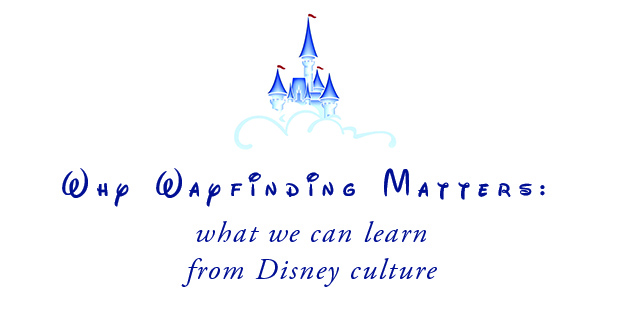
Why Wayfinding Matters: What We Can Learn from Disney Culture
Walt Disney World is aptly named:
Spanning 40 square miles, Walt Disney World Resort is approximately the size of San Francisco, or nearly twice the size of Manhattan. The property features:
- Four theme parks
- Two water adventure parks
- 35 resort hotels (26 owned and operated by Walt Disney World, including seven Disney Vacation Club properties)
- 63 holes of golf on four courses
- Two full-service spas
- Disney’s Wedding Pavilion
- ESPN Wide World of Sports complex
- Disney Springs, an entertainment-shopping-dining complex
On an average day, there are approximately 250,000 people on Walt Disney World Resort property – including Cast Members, other employees and guests.
Walt Disney World Cast Members come from all over the world, representing more than 80 nationalities and speaking more than 50 different languages.
All of which begs the question:
How do people find their way around Walt Disney World?
Wayfinding design provides guidance and the means to help people feel at ease in their surroundings.
– David Gibson, The Wayfinding Handbook
In the 1980s, the design firm Sussman/Prejza was engaged to reimagine the wayfinding and signage system for Walt Disney World (and also for the developing Euro Disney project, now known as Disneyland Paris).
Established in 1968, Sussman/Prejza works with its clients to develop memorable identities and branding, based upon research and graphic archeology. Abstract stories are woven into the visual product, creating a sense of place and memories that users retain and remember. S/P’s work has pushed the boundaries of environmental graphic design to meld cohesively with architecture, civic planning, and landscape design.
The recognized trailblazer in this discipline, Sussman/Prejza’s expertise can be seen in civic, cultural, corporate, sports, institutional, entertainment and retail projects around the globe.
At Walt Disney World, all Guests arrive by highway or freeway, so the main task of Sussman/Prejza was to develop a vehicular signing system that would be “unique in spirit, clean, easy-to-follow, and capable of being expanded as the area continued to grow.”
The theme park was divided into several major “districts.” A hierarchy of signs was established to first lead Guests toward a specific district, and once there, toward a distinct destination. The 1,000-sign system (now greatly expanded) includes large freeway signs, major and minor road directional, regulatory signs, gateways, and bus graphics.
In order to develop a wayfinding system that would cover an area so large while at the same time stay flexible enough for growth, Sussman/Prejza started with a basic color palette and shape guide.
The color palette consists of lavender, blue, and green, chosen to emphasize the black, red, and gold used to create Mickey Mouse. Of the various shapes, the “mouse ears” reinforce the iconic symbol used to represent Mickey Mouse.
Great wayfinding systems employ explicit signs and information as well as implicit symbols and landmarks that together communicate with accuracy and immediacy. Over the last thirty years, wayfinding design has matured to become an essential component of buildings and spaces, helping make sense of a sometimes-overwhelming task: getting from here to there.
What do wayfinding clients need?
The examples below illustrate the range of design projects. The complexity of the project grows in direct proportion to the scale and challenges of the client’s property.
- Individual sign – a single landmark or feature sign
- Wayfinding for building complexes – exterior and interior signage for a group of buildings
- System signage – signage for multiple locations, branches, or franchises operated by one owner or manager, ranging from park systems to consumer banks
- Open space signage – exterior signage for individual parks, streets, or plazas; for trails and greenways; for urban downtowns
- Campus wayfinding – wayfinding system for a group of buildings operating together on one site
- Building signage – signage for an individual structure, exterior and/or interior
Successful wayfinding design depends on understanding three variables:
- The nature of the client organization
- The people with whom the organization communicates
- The type of environment in which the system is installed
Wayfinding in ChurchWorld
As a leader in ChurchWorld, you may be saying, “This is all well and good, but we’re not even meeting our budget or having enough volunteers to serve in our ministries, or …”
People will always need to know where they are, how to reach their destination, what is happening there, and how to exit.
Of all places, shouldn’t the church be clear about wayfinding?
Part Two: The Wayfinding Design Process
Information for this series comes primarily from The Wayfinding Handbook by David Gibson. It is an excellent resource for leaders who want to understand and apply the art and science of wayfinding to their organization.

Tags: Walt Disney World, Wayfinding















